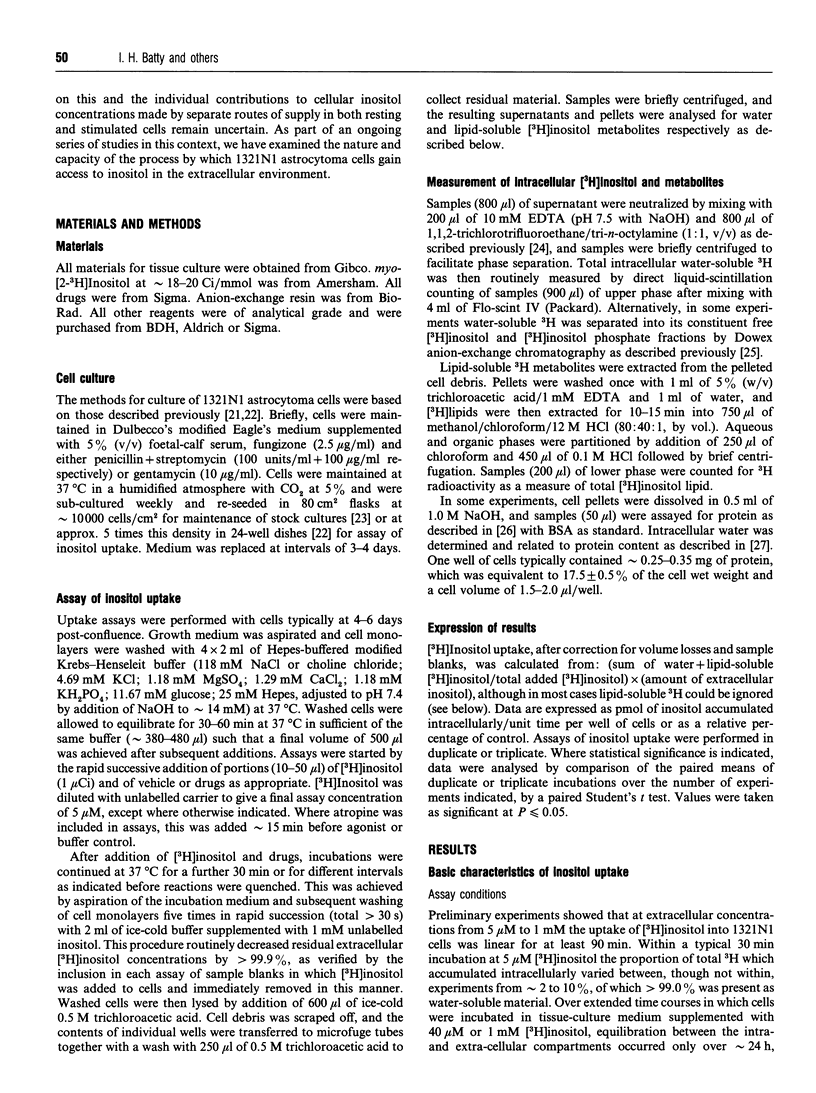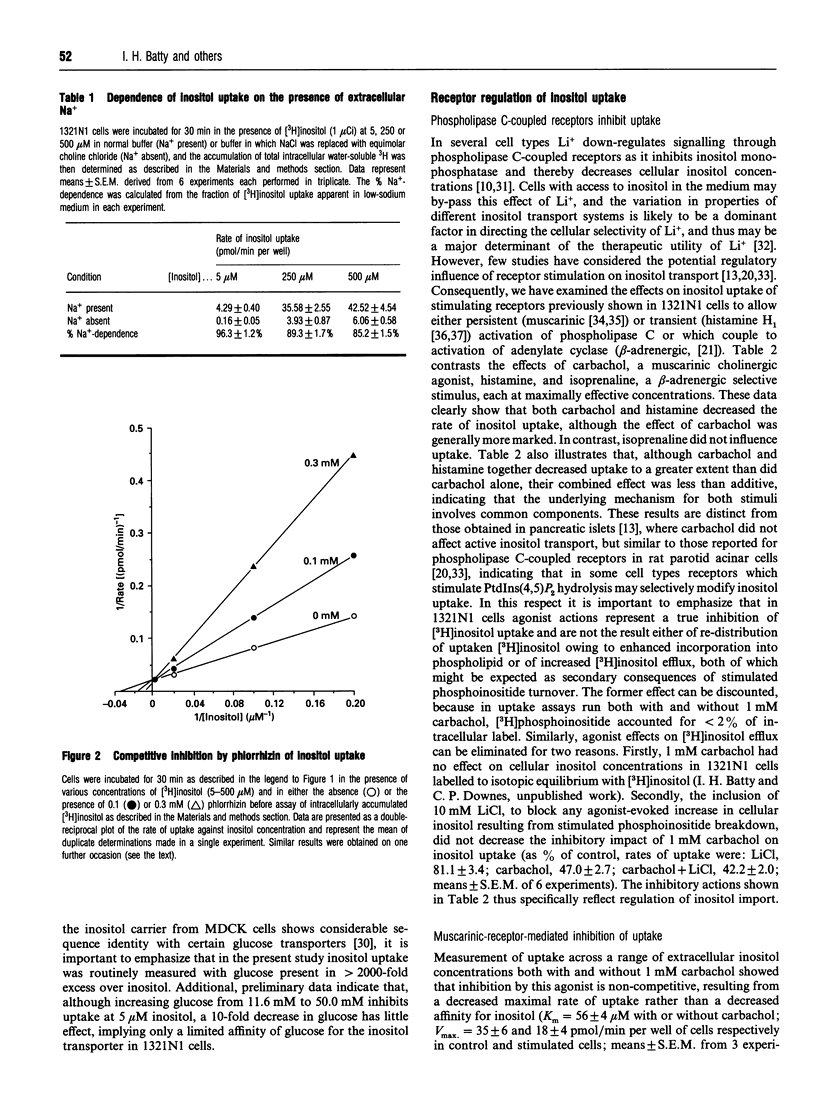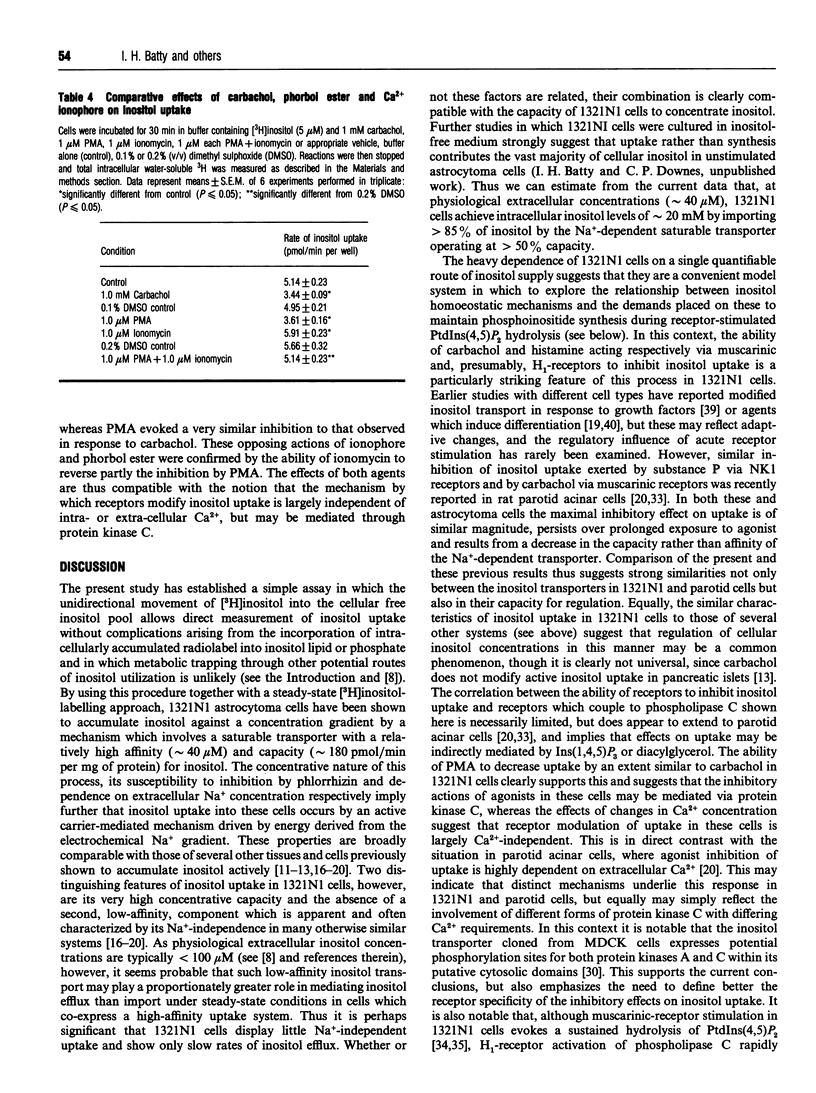Abstract
The uptake of inositol into 1321N1 astrocytoma cells was studied by measurement of the accumulation of free [3H]inositol within the intracellular pool. Uptake occurs via a saturable transporter with apparent Km for inositol approximately 40 microM and Vmax approximately 180 pmol/min per mg of protein, which permits intracellular inositol concentrations to exceed those of the medium by a factor of approximately 500. At extracellular concentrations up to 500 microM, inositol uptake is highly dependent (> or = 85%) on the presence of Na+ in the medium, and at physiological extracellular inositol concentrations, allows inositol to achieve an intracellular concentration of approximately 20 mM, indicating an active process driven by the Na+ gradient. Despite this, uptake was only minimally impaired or was unaffected by ouabain (1 mM) or dinitrophenol (1 mM). Consistent with a carrier-mediated mechanism, uptake was competitively blocked by phlorhizin (K1 approximately 125 microM). Uptake was also inhibited by carbachol and histamine, which act respectively via muscarinic and H1 receptors in these cells to stimulate phospholipase C. Inhibition by carbachol was dose-dependent (EC50 approximately 3-30 microM) and blocked by atropine. Inhibition by carbachol (1 mM) was non-competitive, resulting from approximately 50% decrease in the Vmax for uptake without affecting the Km and was persistent over 30-90 min. Inhibition by carbachol and histamine was independent of extracellular Ca2+ and was reproduced by phorbol ester, but not by Ca2+ ionophore or stimulation of adenylate cyclase. These results imply that receptors which couple to phospholipase C may mediate inhibition of inositol uptake via protein kinase C. The data are discussed in relation to inositol homoeostasis in resting and stimulated cells.
Full text
PDF






Selected References
These references are in PubMed. This may not be the complete list of references from this article.
- Batty I. R., Nahorski S. R., Irvine R. F. Rapid formation of inositol 1,3,4,5-tetrakisphosphate following muscarinic receptor stimulation of rat cerebral cortical slices. Biochem J. 1985 Nov 15;232(1):211–215. doi: 10.1042/bj2320211. [DOI] [PMC free article] [PubMed] [Google Scholar]
- Berridge M. J., Downes C. P., Hanley M. R. Neural and developmental actions of lithium: a unifying hypothesis. Cell. 1989 Nov 3;59(3):411–419. doi: 10.1016/0092-8674(89)90026-3. [DOI] [PubMed] [Google Scholar]
- Berridge M. J., Irvine R. F. Inositol phosphates and cell signalling. Nature. 1989 Sep 21;341(6239):197–205. doi: 10.1038/341197a0. [DOI] [PubMed] [Google Scholar]
- Biden T. J., Wollheim C. B. Active transport of myo-inositol in rat pancreatic islets. Biochem J. 1986 Jun 15;236(3):889–893. doi: 10.1042/bj2360889. [DOI] [PMC free article] [PubMed] [Google Scholar]
- Carpenter C. L., Cantley L. C. Phosphoinositide kinases. Biochemistry. 1990 Dec 25;29(51):11147–11156. doi: 10.1021/bi00503a001. [DOI] [PubMed] [Google Scholar]
- Caspary W. F., Crane R. K. Active transport of myo-inositol and its relation to the sugar transport system in hamster small intestine. Biochim Biophys Acta. 1970 Apr 21;203(2):308–316. doi: 10.1016/0005-2736(70)90145-8. [DOI] [PubMed] [Google Scholar]
- Cheng Y., Prusoff W. H. Relationship between the inhibition constant (K1) and the concentration of inhibitor which causes 50 per cent inhibition (I50) of an enzymatic reaction. Biochem Pharmacol. 1973 Dec 1;22(23):3099–3108. doi: 10.1016/0006-2952(73)90196-2. [DOI] [PubMed] [Google Scholar]
- DeWitt L. M., Putney J. W., Jr Alpha-adrenergic stimulation of potassium efflux in guinea-pig hepatocytes may involve calcium influx and calcium release. J Physiol. 1984 Jan;346:395–407. doi: 10.1113/jphysiol.1984.sp015030. [DOI] [PMC free article] [PubMed] [Google Scholar]
- Dietl M. M., Torrens Y., Beaujouan J. C., Glowinski J. Substance P-induced reduction in the initial accumulation of cytosolic myo-[3H]inositol in rat parotid acinar cells mediated by the NK1 tachykinin receptor. J Neurochem. 1989 Nov;53(5):1640–1643. doi: 10.1111/j.1471-4159.1989.tb08563.x. [DOI] [PubMed] [Google Scholar]
- Downes C. P., Carter A. N. Phosphoinositide 3-kinase: a new effector in signal transduction? Cell Signal. 1991;3(6):501–513. doi: 10.1016/0898-6568(91)90027-r. [DOI] [PubMed] [Google Scholar]
- Downes C. P., Hawkins P. T., Irvine R. F. Inositol 1,3,4,5-tetrakisphosphate and not phosphatidylinositol 3,4-bisphosphate is the probable precursor of inositol 1,3,4-trisphosphate in agonist-stimulated parotid gland. Biochem J. 1986 Sep 1;238(2):501–506. doi: 10.1042/bj2380501. [DOI] [PMC free article] [PubMed] [Google Scholar]
- Downes C. P., Stone M. A. Lithium-induced reduction in intracellular inositol supply in cholinergically stimulated parotid gland. Biochem J. 1986 Feb 15;234(1):199–204. doi: 10.1042/bj2340199. [DOI] [PMC free article] [PubMed] [Google Scholar]
- Evans T., Smith M. M., Tanner L. I., Harden T. K. Muscarinic cholinergic receptors of two cell lines that regulate cyclic AMP metabolism by different molecular mechanisms. Mol Pharmacol. 1984 Nov;26(3):395–404. [PubMed] [Google Scholar]
- Gillon K. R., Hawthorne J. N. Transport of myo-inositol into endoneurial preparations of sciatic nerve from normal and streptozotocin-diabetic rats. Biochem J. 1983 Mar 15;210(3):775–781. doi: 10.1042/bj2100775. [DOI] [PMC free article] [PubMed] [Google Scholar]
- Grafton G., Bunce C. M., Sheppard M. C., Brown G., Baxter M. A. Changes in the kinetics of inositol transport during TPA-induced differentiation of HL60 cells towards monocytes. FEBS Lett. 1991 Jul 29;286(1-2):229–232. doi: 10.1016/0014-5793(91)80980-h. [DOI] [PubMed] [Google Scholar]
- Hallcher L. M., Sherman W. R. The effects of lithium ion and other agents on the activity of myo-inositol-1-phosphatase from bovine brain. J Biol Chem. 1980 Nov 25;255(22):10896–10901. [PubMed] [Google Scholar]
- Harden T. K., Foster S. J., Perkins J. P. Differential expression of components of the adenylate cyclase system during growth of astrocytoma cells in culture. J Biol Chem. 1979 Jun 10;254(11):4416–4422. [PubMed] [Google Scholar]
- Hawkins P. T., Jackson T. R., Stephens L. R. Platelet-derived growth factor stimulates synthesis of PtdIns(3,4,5)P3 by activating a PtdIns(4,5)P2 3-OH kinase. Nature. 1992 Jul 9;358(6382):157–159. doi: 10.1038/358157a0. [DOI] [PubMed] [Google Scholar]
- Irvine R. F. 'Quantal' Ca2+ release and the control of Ca2+ entry by inositol phosphates--a possible mechanism. FEBS Lett. 1990 Apr 9;263(1):5–9. doi: 10.1016/0014-5793(90)80692-c. [DOI] [PubMed] [Google Scholar]
- Kwon H. M., Yamauchi A., Uchida S., Preston A. S., Garcia-Perez A., Burg M. B., Handler J. S. Cloning of the cDNa for a Na+/myo-inositol cotransporter, a hypertonicity stress protein. J Biol Chem. 1992 Mar 25;267(9):6297–6301. [PubMed] [Google Scholar]
- LOWRY O. H., ROSEBROUGH N. J., FARR A. L., RANDALL R. J. Protein measurement with the Folin phenol reagent. J Biol Chem. 1951 Nov;193(1):265–275. [PubMed] [Google Scholar]
- Masters S. B., Harden T. K., Brown J. H. Relationships between phosphoinositide and calcium responses to muscarinic agonists in astrocytoma cells. Mol Pharmacol. 1984 Sep;26(2):149–155. [PubMed] [Google Scholar]
- Masters S. B., Quinn M. T., Brown J. H. Agonist-induced desensitization of muscarinic receptor-mediated calcium efflux without concomitant desensitization of phosphoinositide hydrolysis. Mol Pharmacol. 1985 Mar;27(3):325–332. [PubMed] [Google Scholar]
- Meeker R. B., Harden T. K. Muscarinic cholinergic receptor-mediated activation of phosphodiesterase. Mol Pharmacol. 1982 Sep;22(2):310–319. [PubMed] [Google Scholar]
- Nahorski S. R., Ragan C. I., Challiss R. A. Lithium and the phosphoinositide cycle: an example of uncompetitive inhibition and its pharmacological consequences. Trends Pharmacol Sci. 1991 Aug;12(8):297–303. doi: 10.1016/0165-6147(91)90581-c. [DOI] [PubMed] [Google Scholar]
- Nakahata N., Harden T. K. Regulation of inositol trisphosphate accumulation by muscarinic cholinergic and H1-histamine receptors on human astrocytoma cells. Differential induction of desensitization by agonists. Biochem J. 1987 Jan 15;241(2):337–344. doi: 10.1042/bj2410337. [DOI] [PMC free article] [PubMed] [Google Scholar]
- Nakahata N., Martin M. W., Hughes A. R., Hepler J. R., Harden T. K. H1-histamine receptors on human astrocytoma cells. Mol Pharmacol. 1986 Feb;29(2):188–195. [PubMed] [Google Scholar]
- Olgemöller B., Schwaabe S., Schleicher E. D., Gerbitz K. D. Competitive inhibition by glucose of myo-inositol incorporation into cultured porcine aortic endothelial cells. Biochim Biophys Acta. 1990 Apr 9;1052(1):47–52. doi: 10.1016/0167-4889(90)90056-j. [DOI] [PubMed] [Google Scholar]
- Prpić V., Blackmore P. F., Exton J. H. myo-Inositol uptake and metabolism in isolated rat liver cells. J Biol Chem. 1982 Oct 10;257(19):11315–11322. [PubMed] [Google Scholar]
- Reboulleau C. P. Inositol metabolism during neuroblastoma B50 cell differentiation: effects of differentiating agents on inositol uptake. J Neurochem. 1990 Aug;55(2):641–650. doi: 10.1111/j.1471-4159.1990.tb04181.x. [DOI] [PubMed] [Google Scholar]
- Segal S., Hwang S. M., Stern J., Pleasure D. Inositol uptake by cultured isolated rat Schwann cells. Biochem Biophys Res Commun. 1984 Apr 30;120(2):486–492. doi: 10.1016/0006-291x(84)91280-4. [DOI] [PubMed] [Google Scholar]
- Spector R. Inositol accumulation by brain slices in vitro. J Neurochem. 1976 Nov;27(5):1273–1276. doi: 10.1111/j.1471-4159.1976.tb00343.x. [DOI] [PubMed] [Google Scholar]
- Spizz G., Pike L. J. Growth factors promote inositol uptake in BC3H1 cells. Biochem Biophys Res Commun. 1992 Feb 14;182(3):1008–1015. doi: 10.1016/0006-291x(92)91832-b. [DOI] [PubMed] [Google Scholar]
- Stephens L. R., Hughes K. T., Irvine R. F. Pathway of phosphatidylinositol(3,4,5)-trisphosphate synthesis in activated neutrophils. Nature. 1991 May 2;351(6321):33–39. doi: 10.1038/351033a0. [DOI] [PubMed] [Google Scholar]
- Stephens L., Hawkins P. T., Downes C. P. Metabolic and structural evidence for the existence of a third species of polyphosphoinositide in cells: D-phosphatidyl-myo-inositol 3-phosphate. Biochem J. 1989 Apr 1;259(1):267–276. doi: 10.1042/bj2590267. [DOI] [PMC free article] [PubMed] [Google Scholar]
- Torrens Y., Dietl M., Beaujouan J. C., Glowinski J. Inhibitory effects of substance P and carbachol on the saturable sodium-dependent uptake process of myo-inositol in rat parotid gland. J Pharmacol Exp Ther. 1991 Aug;258(2):639–646. [PubMed] [Google Scholar]
- Yorek M. A., Dunlap J. A., Ginsberg B. H. Myoinositol uptake by four cultured mammalian cell lines. Arch Biochem Biophys. 1986 May 1;246(2):801–807. doi: 10.1016/0003-9861(86)90336-x. [DOI] [PubMed] [Google Scholar]


